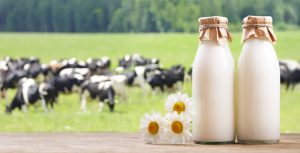Learning how to milk a cow isn’t the same today as it was when our ancestors were alive.
Back then, it was hands and a bucket with the constant fear of being stepped on by a 1,500 pound animal. Today we have cow milking machines that make the milk production process a lot better.
But sometimes curiosity gets the best of us and we wonder how it all works.
To local dairy farmers, milking a cow is a daily occurrence. But to many who live in cities and urban areas, it’s a whole new world. We’re sure you have questions. And we’ve got answers.
Ready to learn how to milk a cow? We’re giving you an inside look at how your milk gets from your local dairy farm to your doorstep.
How to Milk a Cow by Hand
Chances are, you’ll probably never have to milk a cow by hand unless you’re opening a small dairy farm with a few cows.
Here’s a quick step-by-step guide for milking a cow. Before you start, it’s important to check the cow’s udder for signs of illness or injury, like swelling or discomfort. You should never try to milk a cow that might be sick or hurt.
Once you’ve checked the cow and put her in position, you can start milking her using the following steps:
- Wrap your thumb and forefinger around the base of one of the teats, forming a circle.
- Squeeze the teat gently and quickly, which will release a small squirt of milk.
- Repeat this quick squeeze on every teat in order to check that the milk is good, as well as to get rid of any dirt or debris on the udder.
- If the milk appears normal, apply pre-milking product to each teat. This will disinfect the teats before you start milking. Wipe away the product when you’re done cleaning.
- Wrap your thumb and forefinger around the teat again with that circle position.
- Squeeze the teat to get the milk to come out into your bucket.
- Repeat steps 5 and 6 for every teat until the udder is empty.
- Apply post-milking product to the teats.
If you’ve never milked a cow before, make sure you do it under the careful watch of the dairy farmer. It’s harder than it looks- just ask Jimmy Fallon!
Cow Milking Machines
Some cows are milked up to twice a day. With a massive herd, doing this by hand can be time consuming and exhausting.
Many dairy farms use cow milking machines. This technology cuts down on the manual labor the farmers have to perform, and it also allows for faster milk production.
So how do cow milking machines work? First, the farmer inspects the cow’s teats and udder, just like they would do if they were milking by hand.
Next, the machine is attached to the cow’s udder. The machine contains suction cup-like attachments that lock onto each teat and squeeze out the milk.
With these milking machines, it only takes about 5 minutes to milk each cow. The bigger the dairy is, the more machines they can have, and as a result, some farms can milk anywhere from 10 to 20 cows at a time.
So What Happens Next?
Once the milking process is done, the milk is chilled to 39 degrees fahrenheit. When it first comes out of the cow, it’s really warm due to the cow’s internal body temperature, so it needs to be cooled right away.
Then, the milk goes through pasteurization, which involves heating it up to a certain temperature and then cooling it down to allow for removal of bacteria or possible contaminants.
The pasteurized milk is held in a tank for just a few hours, until a tanker picks it up and brings it to the processing facility.
Some dairies have their own processing facilities right on site. There, they package the milk into branded glass bottles or cartons and get it ready to send out.
The milk is then sent to various destinations, including the grocery store, the farm’s on-site store, and to the delivery truck for home milk delivery.
From the Farm to Your Door: How Dairy Delivery Service Works
Farm fresh milk can go from the cow to your doorstep in just 2 days!
You might think home milk delivery is a thing of the past, but the truth is many dairies have been working to bring back the milkman. In fact, some never stopped!
Many dairy farms offer local milk delivery to their customers. Some dairies hire delivery companies, while others have their very own team of eager milkmen who are ready to greet you with a smiling face every week.
You can sign up in many ways, depending on the farm’s options, but most allow you to make your orders online. Each week, you just fill out your order form, and the delivery truck will bring it to your door.
When you’re done with your glass milk bottles, you can keep them to repurpose or you can leave them on your doorstep. Your milkman will pick them up when he brings your next shipment, and they’ll be sent back to the packaging facility to be washed, sanitized, and recycled.
Sign up For Milk Delivery in Glass Bottles to Support Your Local Dairy Farms
To see what local dairy farms are offering home milk delivery in your area, check our database. Drinking milk in glass bottles is a movement to help consumers make the right choice when it comes to buying milk. When you buy your milk in glass bottles, you’re supporting your community, your family, and your local dairy farmers.
Glass milk bottles are also great for the environment because they can be recycled endlessly. You can recycle your glass milk bottles over and over again, which cuts down on pollution from creating new materials.
Sign up for home milk delivery now.
